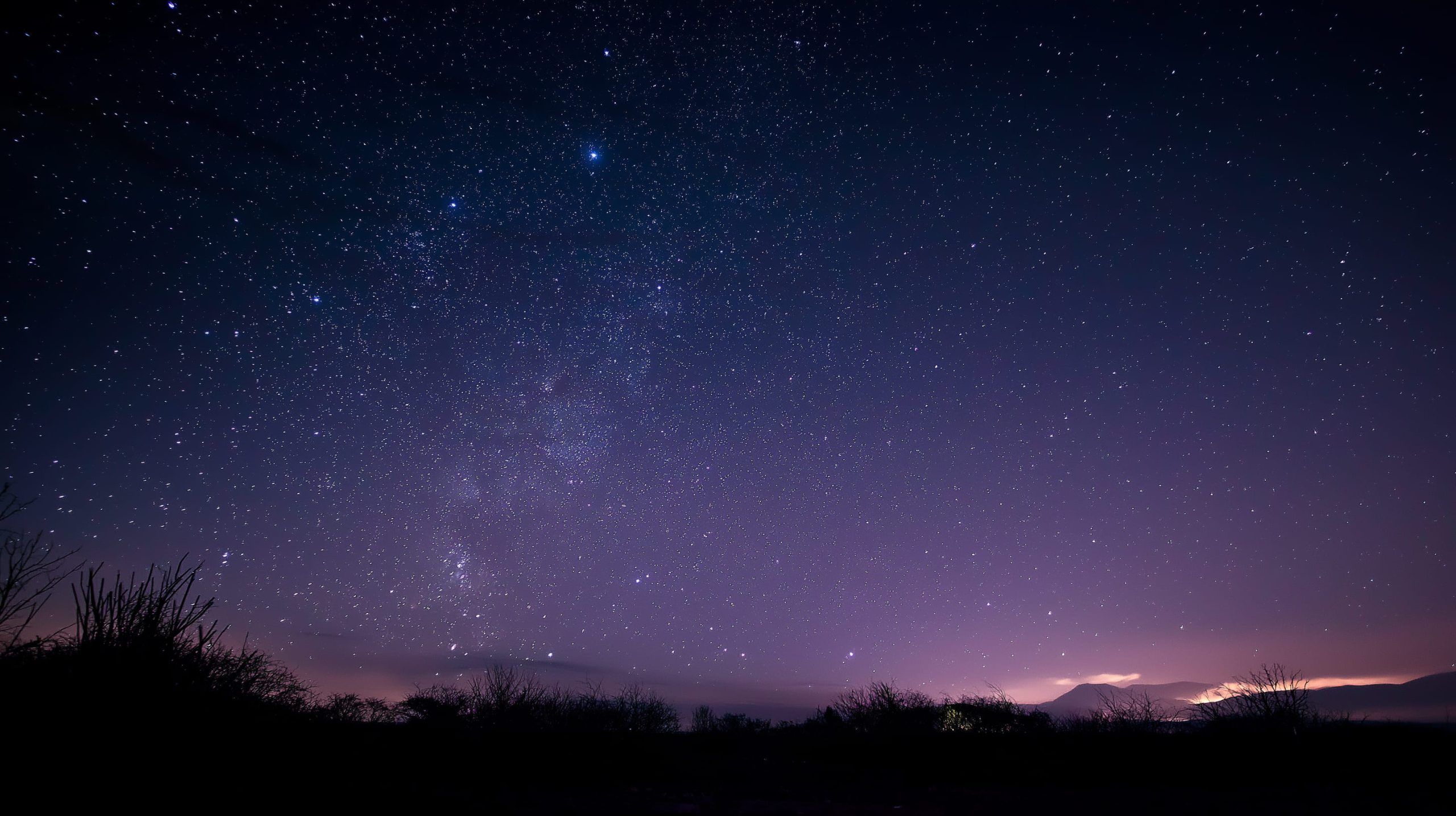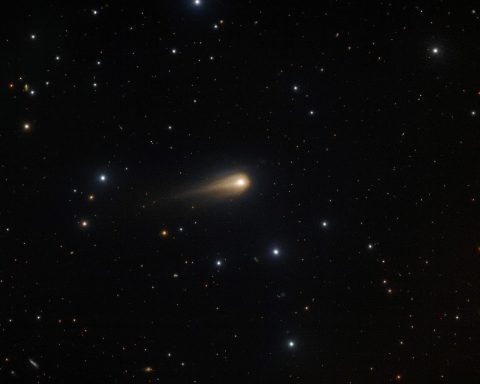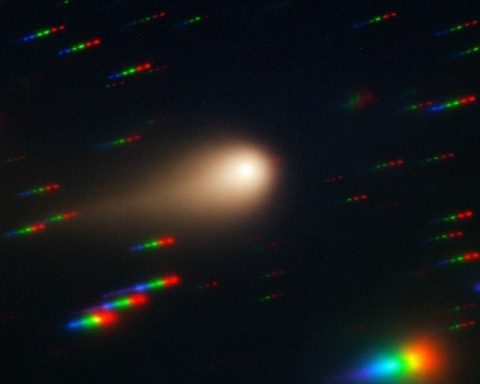- From Aug 18 to 20, a rare six-planet lineup (Mercury through Neptune) may be visible above the horizon before sunrise, with Mercury mag 0, Venus mag −4, Jupiter mag −2, Saturn mag ~0.5, Uranus mag 5.7 and Neptune mag 7.8.
- On the mornings of Aug 19 and 20, Venus and Jupiter form a bright dawn triangle with a slender Moon, with the Moon about 7° above Jupiter on Aug 19 and a few degrees from Venus on Aug 20.
- Titan’s shadow will cross Saturn on Aug 19 around 1:26 a.m. EDT, lasting about 2.5–3 hours, observable with a telescope of ~6 inches or larger.
- Saturn is near its 2025 opposition, which occurs on Sept 21, 2025, and on Aug 18–20 it is bright (mag ~0.4–0.6), rising around 9–9:30 p.m. and visible all night.
- Mercury reaches its greatest western elongation on Aug 19 at about 19°, shining at mag ~0, and it rises roughly 1 hour before sunrise, best observed 30–45 minutes before sunrise with a flat eastern horizon.
- The International Space Station will have multiple visible passes Aug 18–20 for mid‑northern latitudes, since it orbits Earth about every 90 minutes and passes last 4–6 minutes.
- Starlink Group 17‑5 satellites launched on Aug 17 from California could appear as a train of lights around Aug 18–19, visible under dark skies but fainter than the ISS.
- Uncontrolled reentry of the Chinese Long March 5B core, launched on Aug 13, is predicted to occur around Aug 18–19, with a ~30 m long, ~20 metric ton core potentially producing a bright sky fireball over ocean or sparsely populated areas.
- The Perseid meteor shower remains active through Aug 23, and with the Moon a thin crescent on Aug 19–20 observers may see about 5–10 meteors per hour late at night and into the pre-dawn, with occasional bright fireballs.
- There are no solar or lunar eclipses on Aug 19–20, 2025; the next total lunar eclipse is on Sep 7, 2025.
The night sky on August 19–20, 2025 is gearing up for a cosmic extravaganza – from a rare six-planet alignment at dawn, to the tail end of the Perseid meteor shower lighting up the late-night sky, and even a chance for the Northern Lights to make an appearance. Add in brilliant planets like Saturn shining at near-maximum brightness, the International Space Station gliding overhead, and a massive rocket’s fiery reentry, and you have plenty of reasons to look up! Crucially, the Moon will be only a slim crescent (about 15% lit on Aug 19 [1]), leaving dark skies ideal for stargazing. Here’s your complete skywatching guide for Aug 19–20, including what to see, when and where to see it best, and expert tips to maximize your viewing experience.
Viewing conditions: With the waning Moon offering minimal glare, sky conditions are favorable for faint sights like meteors and auroras. Still, clear weather is essential – check your local forecast and plan to be outdoors during clear periods. Try to get away from city lights for the best views: light pollution can hide fainter stars, meteors, and auroras. Allow your eyes at least 20 minutes to adjust to the dark, and avoid looking at bright screens or flashlights. For events near the horizon (like Mercury at dawn), find an unobstructed view (a flat horizon free of buildings or trees). Bundle up if you’ll be out late, bring a comfy chair or blanket, and get ready for an exciting night under the stars!
Meteor Showers: Perseids’ Last Sparkle & Kappa Cygnid Fireballs
- Perseid Meteor Shower (ongoing) – The famous Perseids peaked on Aug 12–13, but they remain active until August 23 [2]. By the nights of Aug 19–20, the Perseids have greatly waned, but the good news is the Moon is now a thin crescent, providing dark skies [3]. You might still catch a few to as many as 5–10 meteors per hour in the late night and pre-dawn hours [4]. The best time is after midnight (when Earth faces into the meteor stream) – lie back, scan the sky, and be patient [5]. Viewing tip: find a safe, dark location away from city lights and let your eyes adapt. Even a week after the peak, occasional bright Perseid fireballs are possible – this shower is renowned for producing spectacular streaks that can leave lingering glowing trails [6]. Under ideal conditions at the peak, the Perseids can produce up to ~100 meteors/hour, but moonlight this year hid many of the dimmer shooting stars [7] [8]. Now that the Moon is out of the way, any stragglers you see will stand out nicely. (Where? Best viewed in the Northern Hemisphere, where the Perseid radiant (in Perseus) rises high. Southern Hemisphere observers will see far fewer Perseids, since the radiant stays low or below the horizon [9].) Meteor expert Robert Lunsford of the AMS notes that even in moonlit conditions “the best rates [at Perseid peak] will probably be near 15 per hour as dim meteors… are hidden”, but thankfully the crescent Moon on Aug 19–20 means little interference [10]. So if skies are clear, it’s worth heading out for a meteor hunt, especially given the Perseids’ reputation for impressive fireballs [11]!
- Kappa Cygnid Meteors (slow fireballs) – After the Perseids steal the show each August, a lesser-known meteor shower quietly graces the sky: the κ-Cygnids. This minor shower is active from Aug 3–28 each year and peaked around Aug 16 [12]. Don’t expect big numbers – perhaps ~3 meteors per hour at best during its peak [13] – but the Kappa Cygnids are famous for bright, slow-moving fireballs that can surprise even seasoned stargazers [14]. In fact, a high point of Cygnid activity occurs roughly every 6–7 years (last seen in 2021), though no outburst is forecast for 2025 [15]. Still, keep an eye out for the occasional very bright meteor. These meteors appear to radiate from the constellation Cygnus (near the star Kappa Cygni), which is high overhead in the evenings for mid-northern latitudes. Northern Hemisphere observers have the advantage here – the Cygnus radiant stays above the horizon all night, increasing the chances of sightings [16]. (In the Southern Hemisphere, the radiant is low or never rises, making κ-Cygnids much harder to see [17].) Viewing is best in the early evening through midnight – notably, the shower’s peak coincided with the last quarter Moon this year, meaning little moonlight interference [18]. If you’re out meteor-watching, you might snag a slow, dramatic fireball that doesn’t belong to the Perseids – a telltale κ-Cygnid. The Astronomy Picture of the Day explains that at their mid-August peak (~Aug 18), the Kappa Cygnids’ rate is only “about 3 meteors per hour, vastly outnumbered by the Perseids” [19], yet they have delivered memorable fireballs in past years. Bottom line: While the Perseids are the main act, the Kappa Cygnids can provide the grand finale with an occasional bright, long-lasting meteor.
Meteor viewing regions: Both showers favor the Northern Hemisphere, especially dark-sky locations. The Perseid radiant is in the northeast (Perseus) and climbs higher past midnight, while the Kappa Cygnid radiant (near Cygnus/Draco) is nearly overhead in mid-northern skies. For Southern Hemisphere observers, Perseid meteors are few (the radiant barely peeks above the horizon), and Kappa Cygnids are essentially out of view. If you’re down under, consider watching for early Southern Delta Aquariids (active in late July) or just enjoy the Milky Way – but for Aug 19–20 specifically, northern skywatchers have the better show. Wherever you are, give yourself at least an hour of watching (meteors come in spurts and require patience), and get comfortable. Pro tip: Bring a blanket or reclining chair, face the general direction of the radiants (northeast for Perseids, overhead or north for Cygnids), but remember meteors can streak anywhere in the sky. Relax and enjoy the summer night – you may also see some random “sporadic” meteors unrelated to major showers.
Auroras & Space Weather: Will the Northern Lights Dance?
The Sun is near the peak of its 11-year cycle (solar maximum), and it’s been firing off frequent solar storms. That means a heightened chance for auroras (Northern and Southern Lights) to appear at high latitudes [20]. Just recently, in May 2024, an extreme solar storm brought the aurora as far south as California and Arizona – an incredibly rare sight at those low latitudes [21]. While nothing that intense is guaranteed for Aug 19–20, the space-weather forecast is promising minor geomagnetic activity. According to NASA/NOAA solar forecasters, a complex of fast solar wind from a coronal hole is due to reach Earth around Aug 18–19, likely sparking G1-class (minor) geomagnetic storms on August 19, possibly extending into Aug 20 [22] [23]. In addition, a small coronal mass ejection (CME) that erupted a couple days prior may graze Earth around late Aug 19 or early Aug 20, potentially enhancing the light show [24]. In other words, aurora hunters at high latitudes, get ready! The official outlook indicates unsettled magnetic conditions building late on Aug 18, with Kp 5 (G1) storms likely on Aug 19 and continued active periods into Aug 20 [25].
What does this mean for skywatchers? If you live in northern-tier U.S. states (around latitude 50° N or above) – think Canada, Alaska, northern Europe (Scotland, Scandinavia), or down south in New Zealand/Tasmania for the Aurora Australis – you have a chance to spot the Northern (or Southern) Lights on these nights. The auroras would likely be moderate, not the dramatic all-sky displays of a major geomagnetic storm, but perhaps visible as a faint greenish or reddish glow low on the horizon, or subtle pulsating curtains of light [26]. The best opportunity is around local midnight to pre-dawn on Aug 19 and again Aug 20, since geomagnetic activity often peaks in the overnight hours. Find a location with a clear view of the northern horizon (or southern horizon if you’re in the Southern Hemisphere) and as little light pollution as possible [27]. Even a minor aurora can be washed out by city lights, so countryside locations are ideal.
Meteorologists and space-weather experts urge optimism but caution. Dr. Kelly Korreck, a NASA heliophysicist, notes that with the Sun so active “we anticipate additional solar and geomagnetic storms leading to opportunities to spot aurora over the next several months” [28] – meaning we’re in an aurora-rich period. And as NOAA Space Weather Coordinator Bill Murtagh explains, “The bigger the storm, the more visible the aurora, [and] the further south it’s visible.” [29] In this case, the expected Aug 19 storm is on the mild side, so auroras will likely “dance around the polar regions” (higher latitudes) rather than dipping too far south [30]. But solar forecasts can change with little notice – a surprise flare or CME could always elevate the show, so it’s worth staying alert. Bottom line: There is no guarantee of auroras on Aug 19–20, but conditions suggest a decent chance for a modest display in northern skies if the solar wind behaves as predicted [31]. Monitor aurora dashboards (such as NOAA’s Space Weather Prediction Center updates or apps like SpaceWeatherLive) on the day of for any alerts. If you’re in the potential viewing zone, check the sky periodically after dark – sometimes auroras start as a faint glow that could be mistaken for light pollution or thin clouds, then intensify. Even if the aurora remains elusive or faint, remember to enjoy the other wonders these nights offer (meteors, planets, Milky Way). And if a surprise stronger storm hits, observers farther south (e.g. northern U.S., central Europe) might get to see the Northern Lights too. It never hurts to look up!
(Note: The term Northern Lights usually refers to the aurora borealis in the Northern Hemisphere. In the Southern Hemisphere, the same phenomenon is the aurora australis, visible from high southern latitudes like Antarctica, Tasmania, or the far south of New Zealand/Argentina. The guidance here applies to both – just face toward the nearest pole.)
Planets & Alignments: Dawn “Planet Parade” and Evening Highlights
Mid-August 2025 offers a smorgasbord of planets in the sky – in fact, all five naked-eye planets (and two telescopic ones) are visible at various times. In the pre-dawn hours, a striking planetary alignment unfolds, while earlier in the night other planets grace the sky. August 18–19 in particular brings a beautiful gathering of the Moon, Venus, and Jupiter at dawn, plus opportunities to spot Mercury, admire Saturn at its brightest, and even track down distant Uranus and Neptune. It’s truly a planet parade – here’s what to look for and when:
- Venus & Jupiter with a Crescent Moon (Dazzling Dawn Trio): Early risers on Aug 19 and 20 are in for a treat: the two brightest planets, Venus and Jupiter, have been shining side-by-side in the east before sunrise, and on these mornings a delicate waning crescent Moon joins them [32]. Venus and Jupiter reached an extremely close conjunction (~1° apart) on Aug 11–12 [33] [34], and by the 19th–20th they remain only a few degrees apart in the sky [35]. Venus blazes super-bright (around magnitude –4), easily the most brilliant point of light in the pre-dawn sky, earning its nickname “Morning Star” [36]. Jupiter appears nearby, a bit fainter (mag ~–2) but still outshining any true star [37] – look for a steady, golden-white glow (planets don’t twinkle as much as stars). On the morning of August 19, the slender Moon will sit just above Jupiter – only about 7° apart (roughly a palm’s width at arm’s length) [38], forming a lovely triangle with Venus, which is a little lower down. By the next morning (Aug 20), the Moon will have moved eastward in its orbit and will appear just a few degrees away from Venus instead [39]. In both cases, the Moon+Venus+Jupiter trio makes for a must-see tableau in the eastern sky before sunrise [40]. It’s a perfect photo opportunity and a stunning sight even to the naked eye – imagine a thin crescent Moon (with earthshine dimly illuminating its dark side) nestled next to two brilliant planet-beacons. When and where to look: Start watching about 2 hours before your local sunrise (around 4–5 AM local time, depending on your latitude) while the sky is still dark [41]. Face east. Venus will be about 20–30° above the horizon (one to two hand-spans high) [42], with Jupiter slightly above/left of Venus. The Moon on the 19th will be above the pair, on the 20th below them. As dawn twilight grows, these three will be among the last objects visible against the brightening sky – a beautiful sight even from cities (Venus and the Moon are bright enough to pierce moderate light pollution). Don’t wait too close to sunrise, or you’ll lose them in the glare. Fun fact: Such multi-planet gatherings are sometimes called a “planetary parade.” In fact, around Aug 18–19, six of the planets plus the Moon are above the horizon simultaneously before sunrise (see “Six-Planet Lineup” below). So enjoy this rare configuration of the heavens! [43]
- Six-Planet Lineup at Dawn (Mercury through Neptune): The mornings of Aug 18–20 potentially let you see six planets at once – a true solar system lineup. Along with Venus, Jupiter, and the Moon’s pairing, Mercury, Saturn, Uranus, and Neptune are also positioned such that, in principle, all these worlds are above the horizon in the same pre-dawn timeframe [44] [45]. The catch: not all are easy to see! Here’s the breakdown: Mercury (mag ~0) will be very low in the east, Saturn (mag ~0.5) will be sinking low in the west, and Uranus (mag ~5.7) and Neptune (mag ~7.8) are faint and require optical aid. The best time to attempt this planet parade is roughly 45–60 minutes before sunrise on Aug 19, when the sky is just beginning to brighten. You’ll have Venus, Jupiter, and the Moon nicely visible higher up. Closer to the eastern horizon, try to spot Mercury (see Mercury section below for tips). Meanwhile, look toward the southwest/west: Saturn should still be detectable (a golden “star” low in the west, if you have a clear view in that direction). Uranus and Neptune are tougher: Uranus will be in the southeast sky higher up (between Jupiter and Saturn’s positions), possibly glimpsed with binoculars as a tiny greenish star in Aries. Neptune is near Saturn in the sky (in western Pisces) but far too dim to see without a telescope [46]. In practice, seeing all six planets will require excellent conditions and likely binoculars/telescope for the dimmest ones. It’s an expert-level challenge, but knowing they’re all out there can still enrich your skywatching. Even if you only easily see 4 (Mercury, Venus, Jupiter, Saturn), that’s an achievement. As Sky & Telescope and other experts note, these multi-planet “alignments” are more about geometry than a literal line – the planets span a wide swath of sky, from the east (Mercury/Venus/Jupiter) to south (Uranus) to west (Saturn). Northern Hemisphere viewers have an edge for the morning alignment: the ecliptic (planetary plane) is angled high, making Mercury a bit easier to catch [47] [48]. (For the record: Mars is the only major planet not participating – it’s too close to the Sun this month and thus not visible at dawn [49].) If you want to verify the fainter planets, a sky map or astronomy app can be handy to pinpoint Uranus/Neptune’s positions relative to brighter stars. But whether you hunt for all six or just enjoy the gorgeous Moon-Venus-Jupiter grouping, the dawn of Aug 19–20 will truly showcase a planetary parade in our skies [50].
- Saturn – The Ringed Jewel (Visible All Night):Saturn is coming into prime time! In late August 2025, Saturn is nearing its yearly opposition (when it’s directly opposite the Sun in the sky and closest to Earth). The exact opposition occurs in September (Saturn will reach opposition on Sept 21, 2025, shining at about magnitude 0.6 at its brightest [51] [52]), but even on Aug 18–20, Saturn is essentially at peak visibility for the year – bright, large, and visible all night long. Look for a moderately bright, yellowish “star” in the east in the mid-to-late evening. According to NASA, Saturn in August rises around 10:30 p.m. at the start of the month and by around 8:30 p.m. by late August, and it stays visible until dawn, reaching high in the southern sky by early morning [53]. By Aug 19, Saturn is rising roughly 9–9:30 p.m. local time in the east-southeast. Once it’s up, you can enjoy Saturn at any time of night – by midnight it will be high in the south, and it sets in the west near sunrise [54] [55]. How to spot it: Saturn is currently in the constellation Aquarius (near the Pisces border). It doesn’t twinkle much, and has a steady, golden light. Its brightness (around mag +0.4 to +0.6 this week [56] [57]) rivals that of the brightest stars, so it’s quite easy to identify once risen – though not as eye-catching as Venus or Jupiter. You won’t see its rings with the naked eye, but even a small telescope or good binoculars magnifying ~20x or more can reveal Saturn’s rings (which in 2025 are tilted nearly edge-on to Earth – so they appear as a thin line rather than wide open [58]). Those rings are still visible with a telescope, just not as dramatic due to the shallow tilt. If you do have access to a telescope, don’t miss a special event on the night of Aug 18–19: Saturn’s largest moon, Titan, will cast its shadow onto Saturn’s cloud tops – a Titan shadow transit [59]. This rare eclipse-like event starts around 1:26 a.m. EDT on Aug 19 (which is late evening Aug 18 for western North America) and lasts ~2.5–3 hours [60]. Essentially, a tiny black dot (Titan’s shadow) will trek across Saturn’s face. You’d need a decent-sized telescope (~6 inches or larger) and steady conditions to see it, but it’s a pretty special observation (after 2025, such moon shadows on Saturn will become very infrequent for years) [61]. Even if you’re not equipped for that, simply gazing at Saturn with your eyes or binoculars is rewarding – remember, that “star” you see is a gas giant ~1.4 billion km away, with a stunning ring system and dozens of moons. Take a moment to appreciate it! Saturn will remain a prominent evening object for the rest of the year, but right now is among the best times to see it at its brightest and longest. (Viewing tip: If you’re at a star party or know someone with a telescope, ask for a look at Saturn – seeing the rings in real time is often a jaw-dropping experience for first-timers.)
- Mars – A Fading Ember in the West:Mars is the lone major planet that’s not putting on much of a show this month. The Red Planet has dramatically dimmed since its last opposition (which was in late 2022); by Aug 2025 it’s on the far side of its orbit from us. Mars is currently lingering in western Virgo as a small, reddish 1.6-magnitude “star” [62] [63]. You can still spot it briefly after sunset in the west, but it’s very low on the horizon and sets only an hour or two after the Sun [64]. Around 30–45 minutes post-sunset on Aug 19, look toward the west where the sky is still twilight-blue – Mars will be about ~5–10° above the horizon (approximately a fist-width at arm’s length) [65]. It won’t be obvious; you’re looking for a faint, steady light with a subtle orange tint. By late dusk (~1–2 hours after sunset) Mars will have disappeared below the horizon. Essentially, Mars is “hanging on by a thread” in the evening sky and will soon be lost in the Sun’s glare for a while. If you manage to see it, congrats – you’re catching Mars at its feeblest. No significant Mars events are happening on these dates, but if you’re keeping track: Mars is sliding toward the far side of the Sun from Earth’s perspective and will re-emerge in the morning sky by late 2025 dramatically brightening for a December 2025 opposition. For now, enjoy the novelty of finding the Red Planet in twilight (maybe use binoculars to pick it out of the glow). Mars is a reminder that not every planet is always bold – sometimes they quietly depart the stage for a time. (Fun note: On Aug 19, Mars is about 250 million km from Earth and appears only 5 arcseconds wide in a telescope – essentially a tiny dot with hardly any detail [66]. So don’t expect much in telescopes this time. Patience – Mars will be much more exciting by the end of 2025!)
- Mercury – Quick Morning Challenge:Mercury, the innermost planet, is notoriously tricky to spot – but mid-August offers one of the better chances this year for Northern Hemisphere observers. August 19 marks Mercury’s greatest western elongation, meaning it’s at its maximum apparent distance west of the Sun, in the morning sky [67] [68]. Essentially, this is when Mercury is as far from the Sun’s glare as it gets (about 19° separation on the sky [69]), making it (in theory) easiest to see before sunrise. Around Aug 18–20, Mercury rises about ~1 hour before the Sun, and will hover very low in the eastern twilight. At greatest elongation on Aug 19, Mercury shines at approximately magnitude 0 (about as bright as a medium-bright star) [70]. When and how to find it: About 30–45 minutes before sunrise, face east and scan near the horizon for a faint, star-like point of light. It will be located to the lower left of Venus and Jupiter (which are much higher up) – essentially Mercury is below that brilliant Venus/Jupiter pairing, much closer to the horizon in the dawn glow [71]. Because Mercury is only ~5° above the horizon an hour before sunrise (for mid-northern latitudes) [72], you’ll need a flat, unobstructed horizon (like over the ocean, a prairie, or a low rooftop view) and very clear air. Binoculars are a huge help: sweep slowly just above the horizon where the sky is brightening and you might pick up Mercury’s tiny pinprick of light [73] [74]. Once you think you have it, you can try to observe with eyes alone – it will be tough, but doable if the sky is transparent. Don’t confuse it with Sirius or other stars – at this hour, almost all stars are gone in the glare; Mercury will be the only “star” low in the east aside from Venus/Jupiter up higher. Safety note: Stop looking before the Sun comes up – never scan with binoculars or telescopes after the Sun is near the horizon, to avoid eye damage. Northern Hemisphere advantage: Thanks to the high angle of the morning ecliptic (the path of the planets) in August, Mercury stands a bit higher for northerners, making this elongation favorable [75]. Observers in Europe, North America, and similar latitudes have a shot. Those in the deep Southern Hemisphere will find Mercury extremely low or not visible in the morning (Mercury will switch to being an evening object for the Southern Hemisphere later in August) [76]. If you miss Mercury on these dates, you’ll have other chances in coming months, but Aug 19 is a date astronomers highlight for attempting it [77]. On Aug 21, the thin crescent Moon will actually sit just 5° from Mercury in the dawn, which might help point it out (though by then Mercury will have dimmed slightly to mag +0.5) [78]. Catching Mercury is a little mini adventure – and if you do spot it, give yourself a pat on the back for finding the elusive “messenger” planet of antiquity!
- Uranus & Neptune – Faint Outer Worlds: While Uranus and Neptune are not visible to the naked eye (except Uranus under the darkest skies if you have sharp vision), we include them for completeness. Both gas giants happen to be in the early morning sky as well. Uranus (mag ~5.7) is in Aries and rises by late night; by the pre-dawn hours (~3–4 AM) it is fairly high in the east-southeast [79]. If you have a detailed star chart or an astronomy app, you could try spotting Uranus with binoculars – it will appear as a tiny, very dim star with a slight greenish-blue hue. Knowing exactly which dot is Uranus can be tricky, but the thrill is in knowing you’re looking at a planet ~2.9 billion km away! Neptune (mag ~7.8) is even dimmer and requires a telescope – it currently lies in western Pisces, not far from Saturn on the sky [80]. In fact, around these dates Saturn and Neptune are only a few degrees apart in the constellation Aquarius/Pisces [81]. If you do train a telescope at Saturn, you could use it to hop to Neptune’s precise position (most telescopes won’t show Neptune as more than a tiny bluish dot, but still – that’s the farthest planet, nearly 4.5 billion km out). Observing Uranus or Neptune isn’t necessary for the casual skywatcher on Aug 19–20, but it’s a cool bonus for dedicated amateurs. For most people, just be aware they’re up there beyond naked-eye reach. With optical aid, Uranus may show a small greenish disk, and Neptune an even tinier blue dot [82]. Both will reach opposition later in 2025 (Neptune in late Sept, Uranus in Nov), when they’ll be at their brightest for the year [83] [84]. But if you manage to log them now, you can claim a “solar system sweep” of seeing all 7 planets (Mercury through Neptune) plus the Moon in one night!
Planet viewing summary: Throughout the night of Aug 18–19 (and similarly Aug 19–20), at least one planet is visible at any given time [85]. After sunset, look west to catch Mars twinkling briefly. By mid-evening, Saturn is rising in the east and will be prominent all night. In the hours before sunrise, the east lights up with Venus and Jupiter (and the Moon on these dates), with Mercury making a low appearance below them, and Uranus/Neptune quietly lurking for those who seek them. It’s not often you can feasibly observe every planet in one night – so take advantage of this cosmic alignment if you can. Even casual observers should at least see Venus, Jupiter, Saturn, and the Moon, which are obvious and spectacular. This planetary dance truly highlights the dynamic “wanderers” (planetai) of our sky.
(Tip: If you have kids or friends with a telescope, try looking at Jupiter’s cloud bands and moons in the morning, or Saturn’s rings at night – these sights never disappoint. And keep an eye on Venus’s brilliance; through a telescope Venus now appears as a large crescent as it heads toward inferior conjunction later in the year.)
ISS & Satellites: The Space Station Glides By
While you’re out gazing at natural wonders, don’t forget to also watch for human-made “stars” crossing the sky. Chief among them is the International Space Station (ISS) – the largest man-made object in orbit, about 400 km above Earth, which often makes impressive passes overhead. The ISS orbits Earth ~16 times per day (completing one orbit every ~90 minutes) [86]. When sunlight hits it, the station’s reflective surfaces make it shine brightly against the dark sky. All ISS sightings occur within an hour or two of local sunrise or sunset – that’s the sweet spot when your sky is dark but the ISS is still illuminated by the Sun [87]. During those periods, the ISS looks like a bright, steady-moving point of light sliding across the heavens in a matter of a few minutes [88]. It doesn’t blink or flicker (unlike an airplane), and it moves fast – crossing from one horizon to the other in about 4–6 minutes at a brisk pace (imagine a high-flying jet moving twice as fast as typical) [89] [90].
On Aug 18–19–20, the ISS happens to have multiple visible flyovers for many places around the world [91]. In mid-August the station’s orbit was giving predawn passes over much of Europe and North America, and that pattern continues into these dates [92]. For example, skywatchers in Warsaw, Poland saw a brilliant ISS pass around 4:30 AM local time on Aug 15 [93], and New York City had a pass just before 5:00 AM that day [94]. Similar early-morning ISS flyovers are expected on Aug 18, 19, and 20 for mid-northern latitudes (Europe, U.S., Canada, etc.) [95]. That means if you’re up watching Venus and Jupiter at dawn, keep an eye out for a bright moving “star” zipping by – it could be the space station. Each pass’s timing and path vary by location, so it’s best to lookup your local ISS schedule to know when to watch. NASA’s Spot the Station service (website or app) and the popular Heavens-Above site can provide exact flyover times, directions, and elevations for your town [96]. As a general rule, an ISS pass will typically appear in the west or northwest, move steadily across the sky (often passing overhead or toward the south), and then fade out in the east or southeast as it either goes into Earth’s shadow or descends toward the horizon [97] [98]. Some passes are very high and long (bright and lasting several minutes overhead), others might be shorter or lower to the horizon. If you catch one, it’s a striking sight – the ISS can rival Venus in brightness at its peak, appearing as a swiftly moving star. It’s also a cool thought that there are astronauts up there waving back! (The crew of Expedition 70 will be aboard in August 2025.)
Aside from the ISS, many other satellites adorn the night if you watch for a while. Not all are as bright, but a few are notable:
- China’s Tiangong Space Station: China operates its own space station, Tiangong, which can occasionally be seen as well. It’s a bit smaller and typically slightly dimmer than the ISS, but under good conditions it can appear as a steady moving point similar to a fast airplane (with no flashing lights). If you know when to look, you might catch Tiangong passing over – its orbits are different from the ISS, so it might be visible on different dates/times. Keep an eye on satellite trackers for Tiangong’s predictions if interested. (It’s often ~1–2 magnitudes fainter than ISS, so best viewed under darker skies.)
- Starlink “Satellite Trains”: One of the more intriguing man-made sights in recent years are the Starlink satellite trains from SpaceX launches. These occur when SpaceX launches a batch of dozens of small satellites that initially travel in a closely spaced line. Right after launch (and for a few days after), they can appear as a chain of faint stars moving in unison across the sky [99] [100]. If you haven’t seen it before, it can be eerie – people sometimes mistake it for a fleet of UFOs! In early August 2025, SpaceX launched a new batch of Starlink satellites (the Starlink Group 17-5 mission launched on Aug 17 from California) [101], so around Aug 18–19 it’s possible that some observers might notice a string of lights in the evening or morning sky. They won’t be as bright as the ISS – you’d likely need a dark sky to see the fainter Starlinks, and they tend to be most visible within a day or two of launch when they’re still bunched together [102]. By a week later, they spread out and dim further. If you’re in a very dark area around these dates, keep watch for a peculiar line of moving dots crossing the sky – that’s a Starlink train. (There are many Starlink satellites up now, so even when not in a “train,” you might see one or two gliding by randomly. But the train effect – a dozen or more in a row – only happens shortly after a launch.)
- Other satellites & flares: Countless other satellites are up there; most are faint and go unnoticed. However, if you stare at the sky for long, you’ll likely catch a few random satellite glints. These appear as slow-moving stars or momentary flashes. One famous phenomenon was the Iridium flare – a bright flash caused by sunlight reflecting off Iridium communication satellites’ antennas. Those particular flares have become rare since many Iridium sats were deorbited, but occasional flares from other tumbling objects still occur [103]. If you see a brief, bright flash that isn’t a plane, you likely caught one. Enjoy these little surprises – they’re reminders of the human presence in orbit.
In summary, make the ISS a part of your Aug 19–20 skywatch plan if possible. It’s easy to spot with a little planning, and seeing it drift overhead is inspiring. As NASA describes, the ISS appears “similar to an airplane or a very bright star moving across the night sky, except it does not have flashing lights or change direction” [104]. It’s truly a shared human experience to wave up at our astronauts passing by. If you do catch it, give a wave or a thought to the crew orbiting above – at 28,000 km/h, crossing your sky in minutes. Not many cosmic phenomena come with that personal touch!
(Tip: To differentiate the ISS from a plane – the ISS will not have any blinking red/green lights, and it moves smoothly in a straight line. Planes are usually slower and have blinking strobes. The ISS also generally appears brighter than most planes at cruising altitude.)
Rocket Launches & Space Events: Human Ventures in the Sky
In addition to natural celestial sights, a few human-made space events coincide with Aug 19–20 that might add to the sky show (or at least are exciting to know about):
- NASA Sounding Rockets from Virginia: Starting Aug 18, NASA’s Wallops Flight Facility in Virginia has a launch window open for a series of suborbital sounding rockets as part of a science mission called TOMEX+ (Turbulent Oxygen Mixing Experiment Plus) [105]. These are small research rockets (Terrier-Orion and Black Brant IX) aimed at studying upper-atmosphere phenomena [106]. The launch window runs nightly from Aug 18 to Sept 3, between 10 p.m. and 6 a.m. EDT [107]. This means on the nights of Aug 18–19 and 19–20, there’s a chance one of these rockets will launch in the late night or pre-dawn hours. Now, these launches are localized events – they’re only directly visible if you’re in the region. If you live in the U.S. Mid-Atlantic (e.g. Virginia, Maryland, Delaware, maybe as far as NJ or NC in dark conditions), you might see a brief glow or streak near the horizon during a launch [108]. Past Wallops launches have been visible from several states away on clear nights as a moving point of light or quick streak ascending. Essentially, if you’re in that area and happen to be looking toward coastal Virginia at the right time, you could catch a rocket’s flame climbing into space for a few seconds. NASA usually provides updates on their Wallops social media feeds about specific launch timings [109]. If you’re outside the East Coast, you won’t see these directly, but it’s interesting to know science is happening overhead. (And if you’re attending any local skywatch events on those nights in the region, the organizers might try to time a view of the launch.)
- Spectacular Reentry Fireball (Long March 5B core):Space junk alert! A large piece of rocket debris is expected to make an uncontrolled reentry around Aug 18–19. Specifically, on Aug 13 China launched a Long March 5B rocket, and the massive core stage (approx. 30 m long, 20 metric tons) was left in low Earth orbit [110]. Now gravity is bringing it down. Current predictions (which are always imprecise) indicate this core will tumble back to Earth around August 18 or 19 (give or take a day) [111]. Because it’s uncontrolled, the timing and location of reentry are uncertain – even on the day of reentry, forecasts might have several hours of uncertainty, which translates to thousands of kilometers of possible ground track error [112]. Why does this matter for skywatchers? If this huge object happens to reenter over a populated region at night, it could put on a jaw-dropping sky spectacle: essentially a massive man-made fireball or series of fireballs streaking across the sky as the rocket stage breaks apart and burns [113]. There have been instances of such reentries in the past (earlier Long March cores, etc.), and videos show a slow-moving “meteor” that fragments into multiple pieces, sometimes with bright flares – an incredible sight if you’re lucky enough to be underneath it. Most likely, this rocket core will fall over an ocean or uninhabited area (the odds of hitting any given spot are extremely low, given much of Earth is water or empty) [114]. But there is a non-zero chance that people in some region will witness a fireball event. The U.S. Space Force and other tracking agencies will issue predictions a day or two prior and then refine them within hours of reentry [115] [116]. If you hear news of a projected path over your area at night, definitely go outside at the predicted time and look! The core stage will mostly burn up, though some pieces (like dense engine components) might survive to the ground or ocean [117]. Famed astronomer Jonathan McDowell noted that this Long March 5B core is “the most massive object to make an uncontrolled re-entry in decades” [118], which is why it’s drawn international attention (and criticism, since standard practice is to dispose of rockets more safely). Regardless, from a skywatch perspective, it’s a wildcard event: possibly spectacular, but only if you’re in the right place at the right time. Keep an ear out for any reentry alerts on Aug 18–19. And if by wild chance you see an ultra-bright, fragmentation-trailing fireball in the sky on those nights, you may have witnessed this rocket returning home! (Such an event would last maybe 30–60 seconds at most, moving from horizon to horizon.) It’s a good reminder that our night sky is becoming a busy place not just with natural wonders but also human artifacts.
- Other Rocket Launches: Space activity is bustling in mid-August. Around our target dates, multiple launches are happening (though not necessarily directly visible to most people live): On Aug 17, SpaceX launched a Falcon 9 from California’s Vandenberg Space Force Base, carrying 24 Starlink satellites (this daytime launch isn’t visible at night, but as mentioned, its payloads contribute to potential satellite trains) [119]. On Aug 20, Russia’s Roscosmos is scheduled to launch a Soyuz 2.1a rocket from Baikonur Cosmodrome, carrying the Bion-M No.2 satellite – a biology research mission with animals and plants on board [120]. And on Aug 21, SpaceX is preparing another high-profile Falcon 9 launch (USSF-36 mission) to deliver the U.S. Space Force’s OTV-8 (X-37B spaceplane) into orbit [121]. These launches themselves won’t be visible to you unless you are near the launch sites (e.g., within a few hundred km of Vandenberg in California, Baikonur in Kazakhstan, or Cape Canaveral in Florida for the Aug 21 one). If you are near those areas, a launch can be an amazing sight: a bright rocket flame, and sometimes at dawn/dusk launches a glowing plume or “space jellyfish” effect in the sky. For most of us, though, these will be “felt” only indirectly (like via the satellites they deploy). Still, it’s fun to know that while you’re watching the stars, rockets are flying and expanding our presence in space. It adds a sense of connection between the celestial and the human.
Eclipses: Any in View?
No eclipses – neither solar nor lunar – occur on August 19–20, 2025. The previous eclipse was a total lunar eclipse back on March 14, 2025, and the next one will be another total lunar eclipse on September 7, 2025, visible from North America and parts of Europe [122] [123]. There’s no need to worry about missing an eclipse on these specific dates – the Sun and Moon won’t be performing that particular dance. (If you’re an eclipse chaser, mark your calendar for September 7, 2025 for the lunar eclipse, and there was also a partial solar eclipse earlier on March 29, 2025 [124].) But during Aug 19–20, the Moon is just a slender waning crescent in the morning sky, far from any eclipse alignment. So you can enjoy the night without any sudden darkening of the Moon or Sun.
(In case you’re wondering, “Black Moon” – a second new moon in a calendar month – occurs on Aug 22–23, 2025 [125], but that’s an astronomical calendar oddity and not visible since new moons are dark.)
In summary, the nights of August 19–20, 2025 are brimming with celestial and even technological marvels. Here’s a quick recap of what to catch:
- Meteors: The Perseid meteor shower is still active (if waning) – with dark moonless skies, you might spot a handful of Perseid shooting stars per hour late at night [126]. Watch after midnight for the best chance, and you could be rewarded with the odd fireball leaving a glowing trail [127]. Meanwhile, the minor Kappa Cygnids could drop in a slow-moving fireball or two of their own around midnight [128]. Keep your wish list handy for those “stars”!
- Auroras: Geomagnetic forecasts hint that the Northern Lights may glimmer at high latitudes around Aug 19, thanks to solar winds causing a minor G1 storm [129]. If you’re in places like Canada, Northern Europe, or Alaska, check the northern sky around local midnight – a faint green glow or waviness could mean aurora. It’s not a sure thing, but the Sun’s been feisty, so have a look. As one expert said, “surprise geomagnetic storms are always possible – we’re in an aurora-rich period.” [130]
- Planets:All eyes on the eastern pre-dawn sky – a gorgeous gathering of Venus and Jupiter has been lighting up the mornings, and on Aug 19–20 the crescent Moon makes it a trio [131]. It’s a picture-perfect scene in the east about 1–2 hours before sunrise: the Moon and the two brightest planets forming a celestial triangle [132]. Don’t miss this planetary meetup! If you have clear horizons, see if you can also spot Mercury lurking very low in the glow (Aug 19 is its best morning showing, look ~30 min before sunrise) [133]. In the evening, Saturn is rising and shining nearly at its brightest of the year (visible all night, golden in Aquarius) [134] [135]. And while Mars is faint and low after sunset, you might catch its last flicker in the west. Between dusk and dawn, an impressive six of the planets make appearances – a true “planet parade” for those keeping score [136].
- ISS & satellites: During the post-sunset and pre-sunrise windows, watch for the International Space Station – a bright moving light that could soar overhead for a few minutes [137]. On Aug 18–19–20 there are multiple ISS passes potentially visible from many locations (especially predawn in mid-northern latitudes) [138]. Use NASA’s tools to time it, and enjoy waving to the astronauts on board. You might also glimpse satellite flocks like a Starlink train – a line of tiny lights following each other (if you’re under dark skies shortly after a recent launch) [139]. And of course, plenty of other faint satellites or flashes might grace your sky – the more you look up, the more you notice we share the sky with our own creations.
- Rocket highlights: Although no major rocket launch will streak overhead for most of us on exactly Aug 19–20, space activity is humming. NASA may launch late-night sounding rockets from Virginia (a localized but neat event if you’re nearby) [140]. A big piece of space junk – a Chinese rocket core – is expected to reenter the atmosphere around those dates, potentially giving some lucky (or unlucky) region a brief but spectacular fireball show as it burns up [141]. And space agencies are sending up missions (SpaceX on Aug 17 & 21, Roscosmos on Aug 20) that, while not visible except near the launch sites, contribute to the flurry of human activity in orbit [142] [143]. It’s amazing to consider: even as you watch a quiet night sky, above you satellites are zipping, astronauts are working on the ISS, and rockets are flying. The sky connects us all.
Finally, remember the essentials: clear weather is key (clouds are the ultimate skywatch spoiler, so hope for or travel to clear skies if you can), and darkness helps immensely (get away from bright lights, or at least shield your eyes, to see fainter phenomena like meteors and auroras). The Moon will not be a nuisance – in fact it will enhance the view by adding beauty to the dawn planet scene without washing out the stars. Bring along friends or family, make it fun – a thermos of coffee for the early morning, or some music or star charts for late night.
Aug 19–20, 2025 truly offers a bit of everything: a meteor sprinkle, a possible auroral glow, a planetary spectacle, the Milky Way stretching overhead (August is great for Milky Way viewing in the evening, especially from dark sites), plus the human-made wonders of the ISS and rocket reentries. It’s a wonderful time to look up and experience the dynamic interplay of cosmic phenomena and our own ventures in space [144]. Whether you’re an avid astronomer or a casual stargazer, these nights have something to enchant you. So plan ahead, step outside, and enjoy this cosmic concert – and as always, clear skies and happy skywatching to all!
Sources: This report compiled information from NASA [145] [146], the NOAA Space Weather Prediction Center, the American Meteor Society [147], EarthSky.org [148] [149], Space.com [150], Astronomy Magazine [151], and other expert references (as cited above) to ensure accuracy and the latest updates. Enjoy the show, and don’t forget to share any exciting sightings – the night sky is for everyone! Clear skies!
References
1. ts2.tech, 2. www.amsmeteors.org, 3. ts2.tech, 4. ts2.tech, 5. ts2.tech, 6. ts2.tech, 7. www.space.com, 8. www.space.com, 9. ts2.tech, 10. www.space.com, 11. www.space.com, 12. starwalk.space, 13. apod.nasa.gov, 14. starwalk.space, 15. starwalk.space, 16. starwalk.space, 17. starwalk.space, 18. starwalk.space, 19. apod.nasa.gov, 20. ts2.tech, 21. ts2.tech, 22. earthsky.org, 23. earthsky.org, 24. earthsky.org, 25. earthsky.org, 26. ts2.tech, 27. ts2.tech, 28. ts2.tech, 29. ts2.tech, 30. ts2.tech, 31. ts2.tech, 32. science.nasa.gov, 33. science.nasa.gov, 34. ts2.tech, 35. ts2.tech, 36. ts2.tech, 37. ts2.tech, 38. ts2.tech, 39. ts2.tech, 40. ts2.tech, 41. ts2.tech, 42. ts2.tech, 43. science.nasa.gov, 44. www.skyatnightmagazine.com, 45. www.skyatnightmagazine.com, 46. ts2.tech, 47. www.skyatnightmagazine.com, 48. earthsky.org, 49. www.skyatnightmagazine.com, 50. www.skyatnightmagazine.com, 51. starwalk.space, 52. starwalk.space, 53. science.nasa.gov, 54. ts2.tech, 55. ts2.tech, 56. ts2.tech, 57. starwalk.space, 58. ts2.tech, 59. ts2.tech, 60. ts2.tech, 61. ts2.tech, 62. ts2.tech, 63. ts2.tech, 64. ts2.tech, 65. ts2.tech, 66. www.astronomy.com, 67. earthsky.org, 68. earthsky.org, 69. earthsky.org, 70. earthsky.org, 71. ts2.tech, 72. ts2.tech, 73. ts2.tech, 74. ts2.tech, 75. earthsky.org, 76. ts2.tech, 77. earthsky.org, 78. ts2.tech, 79. ts2.tech, 80. ts2.tech, 81. ts2.tech, 82. ts2.tech, 83. starwalk.space, 84. starwalk.space, 85. ts2.tech, 86. ts2.tech, 87. www.nasa.gov, 88. ts2.tech, 89. ts2.tech, 90. ts2.tech, 91. ts2.tech, 92. ts2.tech, 93. ts2.tech, 94. ts2.tech, 95. ts2.tech, 96. ts2.tech, 97. ts2.tech, 98. ts2.tech, 99. ts2.tech, 100. ts2.tech, 101. ts2.tech, 102. ts2.tech, 103. ts2.tech, 104. www.nasa.gov, 105. ts2.tech, 106. ts2.tech, 107. ts2.tech, 108. ts2.tech, 109. ts2.tech, 110. ts2.tech, 111. ts2.tech, 112. ts2.tech, 113. ts2.tech, 114. ts2.tech, 115. ts2.tech, 116. ts2.tech, 117. ts2.tech, 118. ts2.tech, 119. ts2.tech, 120. ts2.tech, 121. ts2.tech, 122. www.planetary.org, 123. www.planetary.org, 124. www.planetary.org, 125. earthsky.org, 126. ts2.tech, 127. ts2.tech, 128. starwalk.space, 129. earthsky.org, 130. ts2.tech, 131. science.nasa.gov, 132. ts2.tech, 133. earthsky.org, 134. science.nasa.gov, 135. starwalk.space, 136. www.skyatnightmagazine.com, 137. ts2.tech, 138. ts2.tech, 139. ts2.tech, 140. ts2.tech, 141. ts2.tech, 142. ts2.tech, 143. ts2.tech, 144. ts2.tech, 145. science.nasa.gov, 146. science.nasa.gov, 147. www.amsmeteors.org, 148. earthsky.org, 149. earthsky.org, 150. www.space.com, 151. ts2.tech










